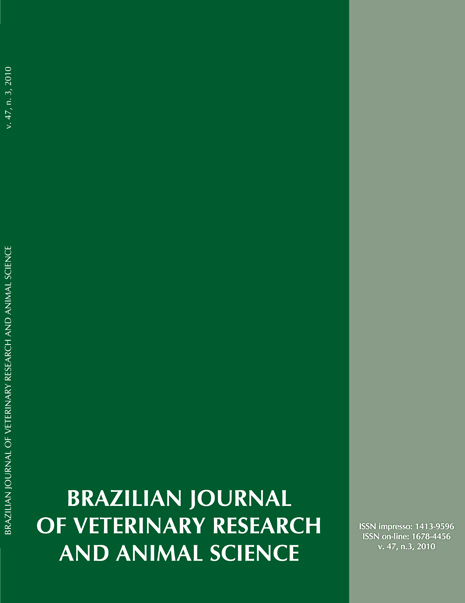Measurement of serum total thyroxine by chemiluminescence method in clinically healthy cats
DOI:
https://doi.org/10.11606/issn.1678-4456.bjvras.2010.26860Keywords:
Cats, Thyroid, Total thyroxine, ChemiluminescenceAbstract
Measurement of serum total thyroxine is the standard method to diagnose feline hyperthyroidism which is now considered the most common endocrine disease in cats. Factors as luminosity and temperature were incriminated as causes for thyroid hormones variation in dogs. The present study aimed to determine reference values for serum total thyroxine in healthy cats in Rio de Janeiro; to compare these findings with values from laboratories inside and outside Brazil and finally, to analyze the effect of gender and age on serum total thyroxine concentration. One hundred nineteen healthy cats, living in Rio de Janeiro for at least five months, from both sex and different breeds were used in this study. Serum thyroxine was measured on 119 samples by Chemiluminescent Enzyme Immunoassay (CEIA) method. Cats aged between five months and 18 years (7.11 ± 3.64). The lowest and highest serum T4 concentration founded in the whole population was 0.44 µg/dL and 4.6 µg/dL respectively. The reference range for this population was 0.75 - 3.5 µg/dL. According to samples included in this study, there was no difference between males and females thyroxine values (α = 0.05). However, age significantly influenced T4 concentrations with a positive correlation (p < 0.05).Downloads
Download data is not yet available.
Downloads
Published
2010-06-01
Issue
Section
UNDEFINIED
License
The journal content is authorized under the Creative Commons BY-NC-SA license (summary of the license: https://
How to Cite
1.
Vieira AB, Castro MCN e, Freire IMA, Coelho MJ, Alencar NX de, Soares AMB. Measurement of serum total thyroxine by chemiluminescence method in clinically healthy cats. Braz. J. Vet. Res. Anim. Sci. [Internet]. 2010 Jun. 1 [cited 2026 Jan. 18];47(3):224-30. Available from: https://revistas.usp.br/bjvras/article/view/26860





